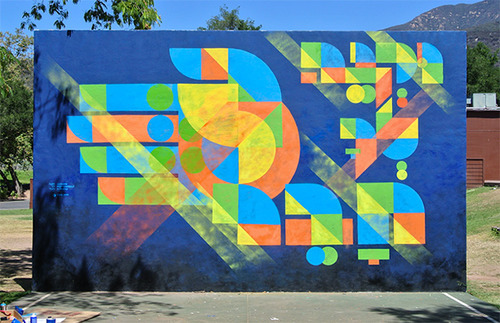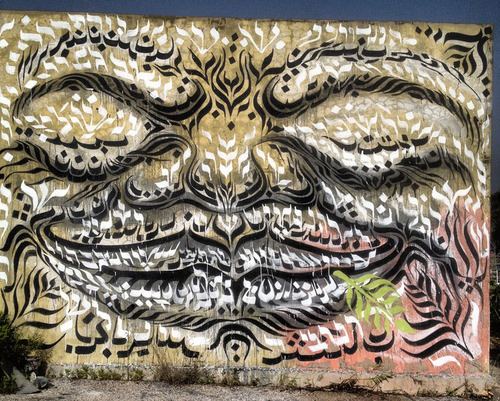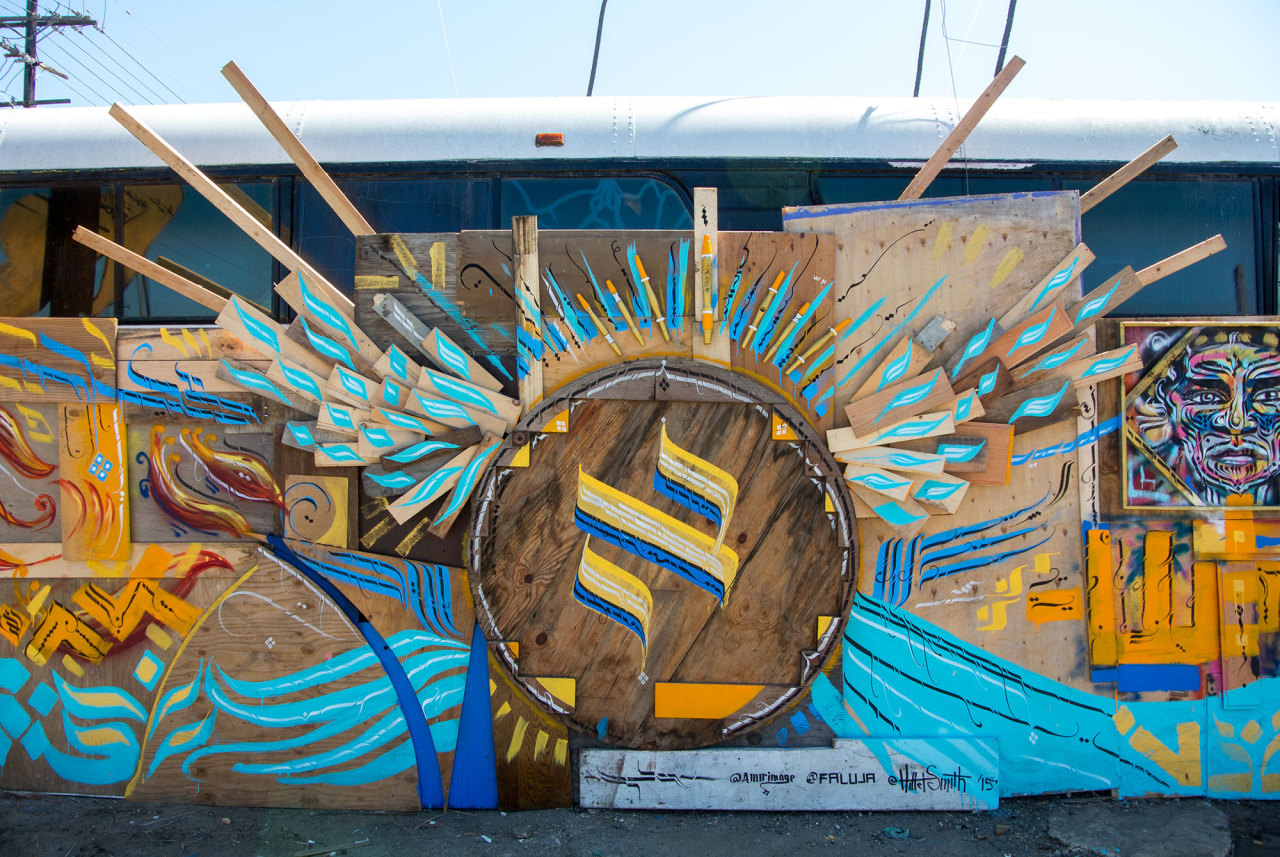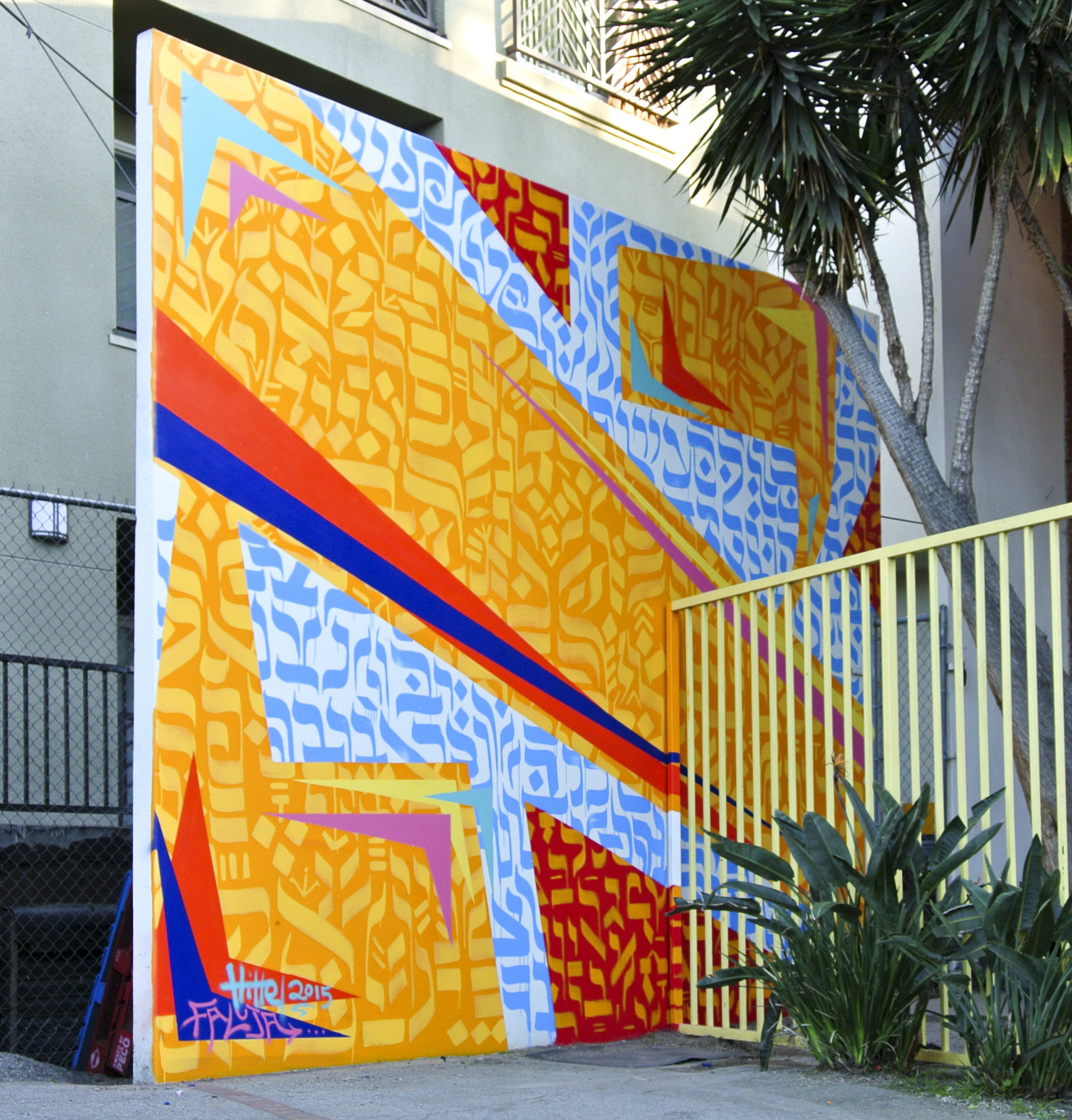At that moment, the fingers of a man’s hand appeared and wrote opposite the lamp on the plaster of the wall of the king’s palace, and the king saw the part of the hand that wrote. Then the king’s color changed and his thoughts terrified him so that his hips became weak and his knees knocked together.
I’d like to apologize for leaving this blog for as long as I did. I’ve been busy. I spent the months of February and March coordinating and then painting murals around Los Angeles with my collaborator, Itamar Paloge (a.k.a. Faluja). Hebrew street art? Jewish graffiti? Sounds pretty awesome, right?
The roots of Jewish mural arts go way back to the earliest days of the Diaspora, if not earlier. The Dura-Europos synagogue in eastern Syria, completed in 244 AD, is famous not only for being one of the oldest synagogues yet found — and so well preserved — but for the paintings covering its walls. A whole collection of synagogues in northern Israel dating from the third to sixth centuries feature vivid mosaics of biblical and historical events. It’s even been proposed that the tradition of Christian iconography and manuscript illumination has its roots in this Jewish art form.

Recreation of the Gwoździec Synagogue in Poland, as documented in the film Raise the Roof
That tradition of lushly painted places of worship reaches its apex in Polish wooden synagogues (at least I think so) of the 17th-19th centuries. Today’s fetish for clean and spare shuls doesn’t compare to the radiant paintings of the the wooden synagogue of Chodorow, and many Polish synagogues like the Tykocin Synagogue, Gwoździec Synagogue, and the Great Synagogue of Dabrowa Tarnowska have been gloriously restored in recent years. The Jews of Eastern Europe were not the only ones to lavishly decorate their synagogues. Communities around the world took elements of the local visual culture — baroque in Italy, Muslim and Hindu decoration in India — to elevate their holy places. This endeavor can more recently be seen in the Art Nouveau-inspired Ades Synagogue and the mosaiced Or Torah Synagogue in Akko.

Hamilton Siddur, currently at the Berlin State Library. Download the entire book here.
For Hebrew typographic art, medieval illuminated manuscripts show the depth of Jewish craftsmanship and the breadth of visual inspiration generations of Jews took from their surroundings. Read more about some of my favorite typographic haggadot on this previous post, and I will write more about illuminated manuscripts in future posts. Designers of the early 20th century continued to apply contemporary design trends to Hebrew and Yiddish work, in particular in Yiddish books (by El Lissitsky and others) and advertising from Mandate Palestine and early Israel.
Meanwhile, in the 1970s in New York City, a subculture of graffiti developed around taggers spray painting their names on subway trains in a style that would become emblematic of urban life. The movement has since found its way across the globe and has found legitimacy as a vital expression of life in the modern age. Why not put this and Hebrew together?
My partner Itamar is an artist born in Jerusalem and now living outside Tel Aviv. He and I met in March 2014 at the Asylum Arts International Jewish Artist Retreat in upstate New York, where we quickly bonded over our shared love of Hebrew typography. After discovering we were both passionate about street art, and street art based on letterforms in particular, we decided to team up to make some together. To that end, we conceived Illuminated Streets, a collaborative mural project that would see the creation of large-scale, contemporary Hebrew art in both of our hometowns. 1


My “Friendship” mural at Camp Ramah in Ojai, CA; and Itamar’s “Coexistence” mural with mock Hebrew and Arabic calligraphy at an abandoned army base in Israel. These were the pieces that drew us to each other’s work.
The philosophy and goals of the project were multi-layered and reflected how we each see street art in relation to our lives and background. For me in LA, I’d always been disappointed that Jewish work wasn’t represented in the rich mural scene that exists in LA, where art draws heavily on cultural and communal identity. If Little Tokyo can have gorgeous Japanese-inspired murals, and Meso-American ones in East LA, what about LA’s Jewish community? Sure, there are a few Jewish murals around, notably the ones at Canter’s and at Workmen’s Circle, but those feature a style of mural that didn’t feel as current or relevant to me as a Jew with modern tastes. American-Jewish identity is very informed by a sense of otherness and the ever-present struggle to successfully meld the two is one I strive to tackle in all of my work. For Itamar, as an artist in Israel where Jews are the majority and the identity battle takes on a very different form, street art fills a different need for personal and political expression. Combining our styles and voices and working with each other on the other’s turf would allow us the opportunity to understand our work in a new way, and inspire others to engage with their Judaism and their neighborhoods in new ways as well. Utilizing Hebrew as a stylistic tool connects us to our shared heritage in a universal way that the literal, representational styles of those older murals could never achieve.
Thanks to grants from Asylum Arts, and from the NextGen Engagement Initiative of The Jewish Federation of Greater Los Angeles, and with support from the Mosse/Weinstein Center for Jewish Studies, University of Wisconsin-Madison and The University of Southern California Initiative for Israeli Arts and Humanities, we were able to make it happen.
We first painted a mural of an enormous neon orange alef at the entrance to the Silverlake Independent JCC. The mural integrates both our styles fairly well: Itamar’s organic paintwork and my angular geometry play off each other to great results. The calligraphy creating that vibrant texture doesn’t say anything and for the most part isn’t even made of real letters. We were inspired by the calligraphic murals of Retna and Cryptik and wanted to put a Hebrew spin on it.

Wisdom Mural at AJU. See photos of the mural’s creation here: Day 1, Day 2, Day 3, and watch the video AJU made about the mural.
Next we painted a mural on the side of the student and conference center at American Jewish University. For this mural, I really wanted to illustrate a full verse — something I do a lot in my own art work — and worked with AJU to find one that we all liked and that suited the institution. We settled on one from the book of Mishlei (Proverbs) 3:13 — “אַשְׁרֵי אָדָם מָצָא חָכְמָה” which translates roughly to “Happy is the person who finds wisdom.” Itamar and I designed the mural collaboratively via email, sending sketches and drafts back and forth until we reached a final design. Again, it encapsulates both of our styles, and uses a contemporary visual style to reinterpret an ancient text.


Our Spirituality mural at the Venice Love Shack in Venice, CA. See tons of photos here, here, and here. Click either of these photos for a larger view.
For the third mural, we enlisted the help of LA-based American-Israeli artist Amir Magal, who connected us with the Venice Love Shack, a quirky collection of art spaces and shops on Lincoln Blvd. in Venice, CA. We first assembled an entire wall nearly 60 feet long out of scrap wood (there was just a chain link fence before) and then painted it improvisationally with more abstract Hebrew calligraphy. The centerpiece features an alef, which in Kabbalah is the letter that catalyzed creation, capped with a keter or crown of glory, out of which extend wings of love, protection, inspiration, and joy. We also enlisted the help of Jewish artists Elke Reva Sudin and Shome Hayun to add their own touches.
We concluded our series with a presentation at the Conney Conference on Jewish Arts, which you can watch here. We were overjoyed to be featured in the Jewish Journal and on NPR/KCRW. We finished the month exhausted and very proud of everything we’d accomplished.
What’s surprising is that we seem to be among the only ones doing this kind of art. In all of my research, the only other person outside Israel I’ve found painting in Hebrew is Kabod Jesko in Venezuela. I did once see a Chabad graffiti panel in Brooklyn, but definitely nothing to constitute a movement.

Mural in Paris by Haifa-based Broken Fingaz. They occasionally write their name on their murals in Hebrew (or Yiddish), but not much else.
In Israel, the story is more complicated. Israel is a jumble of natives, tourists, and emigrants from the world over, secular and religious, conservative and liberal. The Florentin neighborhood of Tel Aviv is famous for its street art (much of it created by Itamar’s friends) which strongly reflects a global street art influence. Aside from political stencil graffiti, typographic pieces are predominantly in Latin letters, not Hebrew. I posit that the globally oriented mindset of the artists points them away from Hebrew, whether to be more accepted outside of Israel or to distance themselves from this isolating heritage. That’s less the case in Jerusalem, where religion and nationalist pride are stronger and Hebrew painting is not as rare.

Mural in Jerusalem quoting Psalm 137:5 – אם אשכחך ירושלים (“If I forget thee, Jerusalem”) outside Mahane Yehuda in Jerusalem, 2008. Photo mine.
In the famous story of the mysterious hand in the book of Daniel, only Daniel can read the “writing on the wall” which portends the imminent fall of Babylon. My own work is often on the edge of legibility, in line with taggers and psychedelic rock posters of the 1960s. If it captures the eye, forcing viewers to look at the work longer engages them more fully with the art. I hope the pieces we’ve created inspire a new generation of Jewish artists (Jewish non-artists, and non-Jewish artists, too) to bring their own interests and heritage to the mix, to be creative with their Judaism, and remake the world anew for their own time and place. Let’s write on those walls!
Update!
To cover the last bit of our budget to bring me to Israel to paint with Itamar in the fall, we’ve launched a crowdfunding campaign at jewcer.com/murals. Please help make this project a reality!
Notes
| ⇧1 | I generally use the term street art rather than graffiti to describe what we do because graffiti has an implication of being illegal. All of our work was fully sanctioned by the property owners. I also think that graffiti doesn’t distinguish between tagging and art, and our work and the work we appreciate surely is more art than surreptitious scrawl. |


